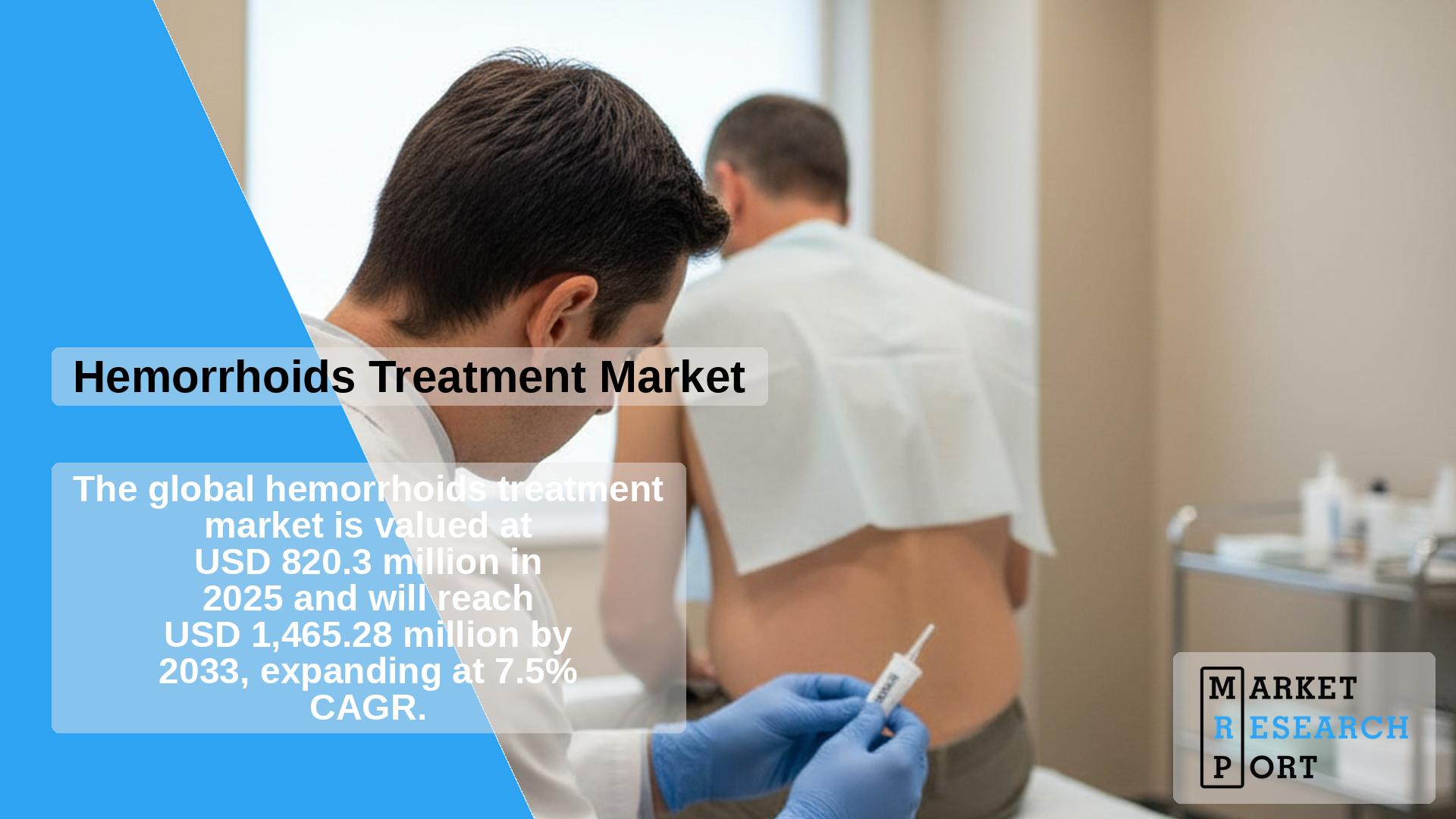
The global hemorrhoids treatment market was valued at approximately USD 818.82 million in 2025 and is expected to reach USD 1,465.28 million by 2033, growing at a compound annual growth rate (CAGR) of 7.5% from 2025 to 2033. The market growth is driven by the increasing prevalence of hemorrhoidal disorders, influenced by sedentary lifestyles, poor dietary habits, rising obesity levels, and aging populations leading to reduced tissue elasticity.
The high global prevalence of hemorrhoids, with estimates suggesting over 50% of certain populations affected at some point in life, drives steady demand for treatments. Mild to moderate cases typically utilize conservative approaches such as dietary fiber, hydration, and sitz baths; whereas severe cases require advanced procedures including rubber band ligation, sclerotherapy, and minimally invasive surgeries.
Technological innovations, including laser therapy, infrared coagulation, and combination drug formulations, offer improved patient outcomes with reduced pain and faster recovery times. Market expansion is further supported by increased patient awareness, diagnostic advances, and growing preferences for effective, accessible, and convenient treatments.
This market exhibits moderate innovation, especially in minimally invasive procedures and pharmacological formulations, focusing on enhanced efficacy, safety, and patient compliance. Manufacturers invest in research to develop topical and oral combination therapies and improve delivery methods.
Market entry is moderately challenging due to significant R&D investment, clinical trial complexities, and stringent regulatory requirements. Established firms dominate distribution and physician trust, creating barriers for new entrants. Regulatory oversight ensures safety and quality, encouraging innovation while protecting consumers.
Alternative products, including herbal remedies and dietary supplements, provide additional choices, affecting competitive dynamics and encouraging product differentiation.
The internal hemorrhoids segment holds the largest revenue share driven by high prevalence and symptom burden requiring medical intervention. Early diagnosis and treatments such as rubber band ligation and infrared coagulation are widely applied to improve recovery and quality of life.
Mixed hemorrhoids are predicted to grow fastest, due to increasing recognition of complex cases needing comprehensive, multimodal treatment approaches combining procedural and pharmaceutical therapies.
Corticosteroids dominate the market as the preferred treatment for inflammation and symptomatic relief, supported by extensive clinical use and patient adherence. Vasoconstrictors also expect rapid growth, attributed to their effectiveness in managing bleeding and swelling associated with hemorrhoids.
Hospital pharmacies dominate owing to their direct involvement in diagnosis, treatment administration, and access to advanced therapies. Online pharmacies are experiencing the fastest growth, driven by increasing consumer desire for convenience, privacy, and broader product accessibility.
| Report Attribute | Details |
|---|---|
| Market Size (2025) | USD 818.82 million |
| Forecast Revenue (2033) | USD 1,465.28 million |
| CAGR (2025–2033) | 7.5% |
| Historical Period | 2021–2024 |
| Forecast Period | 2025–2033 |
| Segments Covered | Disease, Drug Class, Distribution Channel, Region |
| Regions Included | North America, Europe, Asia Pacific, Latin America, Middle East & Africa |
| Countries Included | U.S., Canada, Mexico, UK, Germany, France, Italy, Spain, Denmark, Sweden, Norway, China, Japan, India, Australia, South Korea, Thailand, Brazil, Argentina, South Africa, Saudi Arabia, UAE, Kuwait |
What is the size of the hemorrhoids treatment market in 2025?
The market was valued at approximately USD 818.82 million.
What is the forecasted growth for the market?
The market is expected to grow at a CAGR of 7.5% through 2033.
Which region holds the largest market share?
North America holds the largest share, led mainly by the U.S.
What are the main disease segments?
Internal hemorrhoids account for the largest market share.
Which drug class dominates the market?
Corticosteroids are the leading drug class due to their effectiveness in reducing inflammation and symptoms.
What are the dominant distribution channels?
Hospital pharmacies lead, while online pharmacies are rapidly growing.
Who are the key market players?
Lupin, Cipla, Amato Pharmaceutical, Church & Dwight, Haleon, Bayer, Sanofi, Abbott, and Sun Pharmaceutical are major industry leaders.